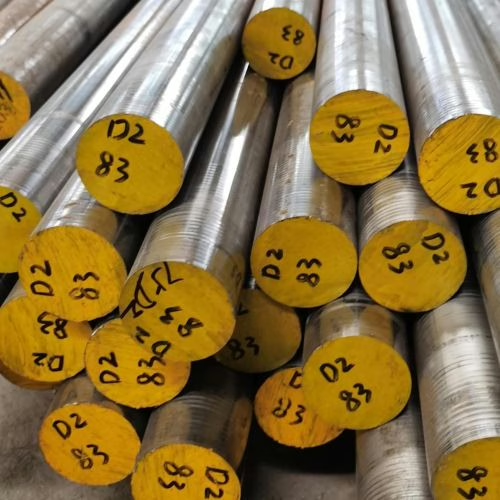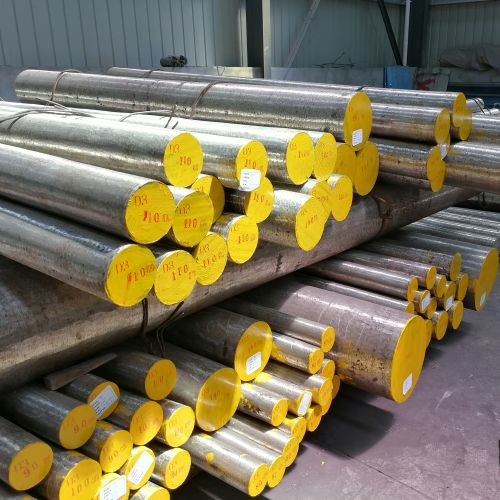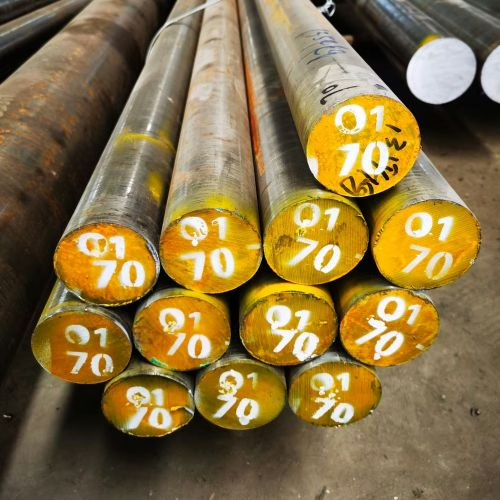
catálogo de aços para ferramentas de trabalho a frio
Catálogo de Aços para Ferramentas de Trabalho a Frio
Clique em qualquer produto para ver detalhes.
O que é aço para ferramentas de trabalho a frio
Aços para ferramentas para trabalho a frio são uma classe crítica de aços-liga projetados especificamente para operações de usinagem em que a temperatura de trabalho é geralmente inferior a 200 °C (390 °F), frequentemente à temperatura ambiente. Isso os distingue dos aços para ferramentas para trabalho a quente, que são usados em aplicações que envolvem temperaturas mais altas (tipicamente acima de 200 °C e até 800 °C).
Classificação
Os aços para ferramentas de trabalho a frio são sistematicamente categorizados, principalmente por AISI (Instituto Americano de Ferro e Aço), em três grupos principais com base em seu meio de têmpera e composição:
- Tipos de endurecimento em óleo (série O): incluem graus como O1, O2, O6 e O7.
- Tipos de liga média endurecíveis ao ar (série A): Exemplos são A2, A3, A4, A6, A7, A8, A9 e A10.
- Tipos com alto teor de carbono e alto teor de cromo (série D): Este grupo inclui D2, D3, D4, D5, D6 e D7. Os aços do tipo D foram inicialmente desenvolvidos para corte em alta velocidade, mas encontraram utilidade como aços para matrizes de trabalho a frio.
A Norma Internacional EN ISO 4957 também classifica aços para ferramentas, com aços para ferramentas para trabalho a frio sendo divididos em categorias de ligas e não ligados.



Propriedades principais e sua interação
- Alta Dureza. Este é um requisito primário, normalmente direcionado a 60 HRC ou mais, para fornecer resistência à deformação plástica sob as altas forças encontradas em operações de trabalho a frio. Uma dureza mais alta está diretamente relacionada a um maior limite de escoamento, evitando que as ferramentas se deformem permanentemente. No entanto, durezas extremamente altas podem reduzir a usinabilidade e a retificação.
- Alta Resistência ao Desgaste. A alta resistência ao desgaste permite que as dimensões da ferramenta permaneçam estáveis por um longo tempo, prolongando assim sua vida útil. Esse desempenho é obtido principalmente por meio de uma matriz dura (martensita) e da presença de partículas de carboneto duro não dissolvidas.
- Boa Tenacidade. Capacidade de resistir a lascas, rachaduras ou quebras sob carga de impacto. Dureza e tenacidade são frequentemente inversamente proporcionais, por isso é importante encontrar um equilíbrio entre as duas. Para trabalhos com impacto, alta tenacidade é a principal consideração, enquanto a resistência ao desgaste é a secundária.
- Estabilidade Dimensional. Quando se exige alta precisão em ferramentas, a estabilidade térmica de alguns aços para ferramentas torna-se muito importante. Nesses casos, o aço endurecível ao ar é o material de escolha.
- Usinabilidade. As ferramentas são geralmente fornecidas em condições macias e recozidas para facilitar a conformação e a usinagem antes do endurecimento final.
Composição e Microestrutura
Aços para ferramentas de trabalho a frio contêm maiores teores de carbono (tipicamente de 0,60% a 2,50%) em comparação com muitos outros aços, o que é fundamental para atingir alta dureza. Eles também são ligados com vários elementos para aprimorar propriedades específicas:
- Cromo (Cr): Um formador de carboneto moderado que contribui significativamente para a resistência ao desgaste, especialmente em tipos com alto teor de carbono e alto teor de cromo (série D). Também melhora a temperabilidade.
- Molibdênio (Mo) e Tungstênio (W): Embora menos comuns do que em aços para trabalho a quente ou aços rápidos, eles podem ser adicionados para melhorar a temperabilidade e contribuir para a resistência ao desgaste, formando carbonetos duros.
- Vanádio (V): Forma carbonetos muito duros do tipo MC (2300-3000 HV) que aumentam significativamente a resistência ao desgaste abrasivo.
- Manganês (Mn) e Silício (Si): Contribui para a temperabilidade e, no caso do Si, pode melhorar a usinabilidade e a resistência à descarbonetação.
A microestrutura de aços para ferramentas endurecidos e trabalhados a frio consiste principalmente de martensita temperada com alto teor de carbono e uma dispersão de vários carbonetos.
- Carbonetos: O tipo e a distribuição dos carbonetos são cruciais. Carbonetos M7C3 ricos em cromo são típicos em aços da série D, proporcionando alta resistência ao desgaste. A quantidade desses carbonetos aumenta com o aumento do teor de carbono e cromo. Classes de ligas mais baixas, como O1, quase não possuem carbonetos devido ao teor insuficiente de cromo.
- Austenita retida (RA): Em aços de alto carbono e alta liga, alguma austenita pode ser retida após a têmpera. Embora a austenita possa absorver tensões devido à sua ductilidade, a austenita retida é indesejável, pois reduz a dureza e pode causar instabilidade dimensional, transformando-se em martensita quebradiça sob tensão, levando a trincas ou lascamento. O controle da austenita retida é obtido por meio da composição, temperatura de têmpera e temperatura de revenimento. Tratamentos abaixo de zero (tratamentos criogênicos) também podem ser aplicados para converter a austenita retida em martensita, melhorando a dureza, a estabilidade dimensional e a tenacidade à fratura.
Tratamento térmico
As propriedades desejadas dos aços para ferramentas de trabalho a frio são obtidas principalmente por meio de procedimentos precisos de tratamento térmico:
- Recozimento. O objetivo do recozimento é reduzir a dureza do aço para ferramentas, facilitando seu processamento. O processo envolve o aquecimento do aço para ferramentas a uma temperatura elevada e a manutenção dessa temperatura por um período de tempo, seguido de resfriamento lento para obter uniformidade estrutural e formação de uma microestrutura amolecida, geralmente acompanhada de esferoidização do carboneto, para obter o desempenho ideal de usinagem.
- Têmpera. Este processo envolve o aquecimento do aço para ferramentas acima de sua faixa de temperatura crítica para formar austenita e, em seguida, resfriá-lo rapidamente para convertê-lo em martensita dura. Os aços para trabalho a frio se distinguem por seus meios de têmpera: água (série W), óleo (série O) ou ar (série A, série D). A têmpera ao ar é preferida para distorção mínima e maior segurança contra trincas. A têmpera em água causa choque térmico severo e distorção. Estes variam significativamente de acordo com o grau, por exemplo, O1 a ~790-815°C (1450-1500°F), A2 a ~980°C (1800°F), D2 a ~1010°C (1850°F) e W1 a ~800°C (1475°F).
- Revenimento. Após a têmpera, a martensita dura e quebradiça é reaquecida a uma temperatura intermediária (revenimento) para amolecê-la ligeiramente, aliviar tensões internas e melhorar a tenacidade. Aços para ferramentas de trabalho a frio são tipicamente revenidos em baixas temperaturas (em torno de 150-300 °C / 300-570 °F) para atingir alta dureza, geralmente em torno de 60 HRC.
Aplicativos
Aços para ferramentas de trabalho a frio são amplamente utilizados em diversas operações de fabricação devido à sua capacidade de suportar alta pressão, impacto e abrasão em temperatura ambiente ou próxima a ela. Aplicações típicas incluem:
- Formando: Matrizes de dobra, matrizes de cunhagem, matrizes de repuxo a frio (por exemplo, W1, W2), matrizes de extrusão a frio, matrizes de trefilação (para fios, barras, estampagem profunda).
- Tosquia e corte: Matrizes de corte, lâminas de corte (quente e fria), facas (trabalho a frio).
- Socos: Punções gerais, punções perfurantes e matrizes.
- Variado: Componentes de máquinas-ferramentas resistentes ao desgaste, ferramentas para trabalhar madeira, ferramentas de medição e fixadores.
- Aplicações resistentes a choques: Os aços da série S (por exemplo, S1, S5, S7) são usados para ferramentas que exigem alta tenacidade, como formões, moldes de prensagem de pó e chapas grossas de corte por cisalhamento.
Perguntas frequentes
Aços para ferramentas de trabalho a frio são uma classe de aços para ferramentas utilizados em operações de usinagem em temperaturas tipicamente abaixo de 200 °C (390 °F), geralmente à temperatura ambiente. São projetados para oferecer alta dureza, resistência mecânica e resistência ao desgaste, obtidas por meio de tratamentos térmicos específicos e da presença de carbonetos grosseiros em sua microestrutura.
Não existe um único aço "melhor", pois a escolha ideal depende dos requisitos da aplicação específica, equilibrando resistência ao desgaste e tenacidade. Os tipos comuns incluem aços de alto carbono e alto teor de cromo (série D), aços endurecíveis ao ar (série A), aços endurecíveis em óleo (série O) e aços resistentes a choques (série S). Aços rápidos (HSS) e aços para ferramentas de metalurgia do pó (PM) também oferecem excelente resistência ao desgaste para trabalho a frio.
A principal diferença reside nas faixas de temperatura de operação e nas propriedades otimizadas. Os aços para ferramentas de trabalho a frio são indicados para aplicações abaixo de ~200-260 °C (390-500 °F) e priorizam alta dureza e resistência ao desgaste. Os aços para ferramentas de trabalho a quente são indicados para aplicações acima dessa faixa de temperatura (até 800 °C ou 1472 °F) e são caracterizados por resistência a quente, resistência ao amolecimento em temperaturas elevadas (dureza vermelha) e tenacidade, frequentemente com dureza inferior à dos aços para trabalho a frio.
O trabalho a frio, também conhecido como encruamento ou encruamento, é a deformação plástica de um metal em temperaturas abaixo de sua temperatura de recristalização, tipicamente à temperatura ambiente ou próxima a ela. Esse processo causa distorções na estrutura interna do metal.
Os principais objetivos do trabalho a frio do aço incluem aumentar a resistência, a dureza e a estabilidade dimensional ou microestrutural, bem como melhorar a resistência ao desgaste. Também produz um acabamento superficial liso e limpo, alcança maior precisão dimensional e pode melhorar a usinabilidade, facilitando a quebra de cavacos.
Sim, o trabalho a frio aumenta diretamente a dureza do aço. À medida que a deformação plástica aumenta, a estrutura interna se distorce, dificultando a deformação adicional e aumentando tanto a resistência quanto a dureza do metal.
"Aço frio" normalmente se refere ao aço que passou por "trabalho a frio" (por exemplo, laminação a frio ou trefilação a frio) à temperatura ambiente, o que aumenta sua dureza, resistência e proporciona melhor acabamento superficial e controle dimensional. "Aço comum" pode se referir ao aço laminado a quente, que é processado em altas temperaturas, geralmente resultando em uma superfície mais rugosa e menor dureza, mas com maior ductilidade inicial.
Não, o trabalho a frio em si não diminui o tamanho dos grãos; ele distorce e alonga os grãos existentes. O refinamento dos grãos (tornando-os menores) ocorre durante um processo de tratamento térmico subsequente chamado recozimento, que promove a recristalização de novos grãos mais finos após o trabalho a frio.
A porcentagem de trabalho a frio é normalmente calculada como a redução percentual na área da seção transversal ou espessura do material. Por exemplo, uma redução de espessura de 70% significa que a espessura do material foi reduzida em 70% devido ao trabalho a frio.
O trabalho a frio é amplamente utilizado para melhorar as propriedades mecânicas do aço (como resistência e dureza), obter dimensões precisas e acabamentos superficiais lisos, além de aumentar a usinabilidade. É aplicado em processos como laminação a frio de chapas e tiras, trefilação a frio de barras e arames, recalque a frio, cunhagem e extrusão, especialmente para componentes automotivos, aeroespaciais e de engenharia em geral.
O trabalho a frio é realizado em temperaturas abaixo da temperatura de recristalização do metal, normalmente à temperatura ambiente ou próxima dela. Embora o processo em si possa gerar algum calor devido à deformação, o material geralmente começa à temperatura ambiente.
O trabalho a frio aprimora propriedades mecânicas como resistência, dureza e limite de escoamento, melhora o acabamento superficial e a precisão dimensional, além de permitir melhor reprodutibilidade e intercambialidade das peças. Também minimiza problemas de contaminação e pode conferir propriedades direcionais desejáveis.
O trabalho a frio é a deformação plástica em temperaturas nas quais o recozimento não ocorre rapidamente, levando ao endurecimento por deformação, aumento da resistência e diminuição da ductilidade. O recozimento é um tratamento térmico que amolece materiais metálicos, alivia tensões internas e restaura a ductilidade por meio de aquecimento e resfriamento a uma taxa adequada, frequentemente revertendo os efeitos do trabalho a frio.
"Trabalho a quente" e "trabalho a frio" geralmente se referem à temperatura na qual um aço para ferramentas é projetado para operar. Aços para ferramentas para trabalho a quente são para aplicações em altas temperaturas (acima de ~200 °C), exigindo dureza a quente e resistência ao amolecimento em temperaturas elevadas. Aços para ferramentas para trabalho a frio são para aplicações em temperatura ambiente, com foco em alta dureza, resistência ao desgaste e tenacidade. Separadamente, trabalho a quente e trabalho a frio também são processos de conformação de metais que ocorrem acima e abaixo da temperatura de recristalização, respectivamente.
Não, o trabalho a frio diminui a ductilidade do metal e aumenta sua dureza e resistência. Para restaurar a ductilidade para posterior deformação, frequentemente é necessário recozimento intermediário.
O trabalho a frio do aço inoxidável envolve sua deformação à temperatura ambiente para aumentar sua resistência, dureza e, às vezes, induzir a formação de martensita (especialmente em tipos austeníticos), enquanto diminui seu alongamento. Geralmente, requer forças maiores do que os aços carbono trabalhados a frio devido às maiores taxas de encruamento do aço inoxidável.
Sim, o Tipo 316 é um aço inoxidável austenítico que pode ser trabalhado a frio81373. Aços inoxidáveis austeníticos, incluindo o 316, são comumente submetidos a processos de trabalho a frio, como o recozimento a frio296482. A laminação a frio, mesmo em temperaturas abaixo de zero, pode ser usada para induzir martensita e aumentar sua taxa de encruamento373.
Aços para ferramentas de trabalho a quente são uma categoria de aços para ferramentas especificamente projetados para operações de corte ou conformação em que a peça ou a ferramenta em si atingirá temperaturas elevadas, tipicamente acima de 200 °C. Sua principal característica é a "dureza a quente", o que significa que mantêm sua resistência e dureza em altas temperaturas. Também apresentam boa tenacidade e resistência ao desgaste em condições quentes. Exemplos comuns incluem os aços AISI da série H.
Aço inoxidável refere-se a uma família de aços de liga caracterizado por alta resistência à corrosão devido a um teor mínimo de cromo 10,5…. “Aço frio” não é um tipo de aço, mas geralmente se refere a “aço acabado a frio”, que descreve aços carbono ou ligas que foram processados à temperatura ambiente (trabalho a frio, torneamento, retificação) para obter características específicas, como precisão dimensional aprimorada, acabamento superficial mais liso e maior resistência e dureza por meio do endurecimento por trabalho20…. Portanto, o aço inoxidável é um material composição, enquanto “aço frio” se refere a um método de processamento aplicado a diversas composições de aço.
Obtenha sua vantagem competitiva com aço para ferramentas premium
Aproveite nossos mais de 20 anos de experiência em forjamento. Não vendemos apenas aço; oferecemos soluções personalizadas. Entre em contato com nossos especialistas para obter informações detalhadas e um orçamento altamente competitivo.
Orientação especializada, preços líderes de mercado.
